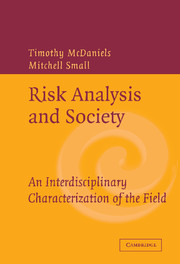Book contents
- Frontmatter
- Contents
- Contributors
- 1 Introduction – Risk Anaysis and Society: An Interdisciplinary Characterization of the Field
- PART ONE FUNDAMENTAL CHARACTER OF RISK
- PART TWO METHODS FOR RISK ASSESSMENT
- PART THREE NEW APPROACHES AND NEEDS FOR RISK MANAGEMENT
- 9 The Challenge of Integrating Deliberation and Expertise: Participation and Discourse in Risk Management
- 10 Global Change and Transboundary Risks
- 11 Environmental Risks and Developing Countries: An Asian Perspective
- SUMMARY AND FUTURE DIRECTIONS
- Index
- References
10 - Global Change and Transboundary Risks
Published online by Cambridge University Press: 05 June 2012
- Frontmatter
- Contents
- Contributors
- 1 Introduction – Risk Anaysis and Society: An Interdisciplinary Characterization of the Field
- PART ONE FUNDAMENTAL CHARACTER OF RISK
- PART TWO METHODS FOR RISK ASSESSMENT
- PART THREE NEW APPROACHES AND NEEDS FOR RISK MANAGEMENT
- 9 The Challenge of Integrating Deliberation and Expertise: Participation and Discourse in Risk Management
- 10 Global Change and Transboundary Risks
- 11 Environmental Risks and Developing Countries: An Asian Perspective
- SUMMARY AND FUTURE DIRECTIONS
- Index
- References
Summary
INTRODUCTION
Risks that are generated under one regulatory jurisdiction and have significant actual or anticipated impacts in another, regionally or globally, are a source of concern for regulators, politicians, and the public. Attempts to control and regulate such risks and to bring in systems of liability for damage are often regarded by industry as restricting competitiveness and inhibiting innovation (House of Lords Select Committee on Science and Technology, 1993; Leonard, 1988). On the other hand, to take a more optimistic view, transboundary risk issues and their mitigation have been at the forefront in stimulating international collaboration among governments and public and private institutions. Success in this area, although limited, has been greater than in many others.
A diverse spectrum of issues can be included under the heading “transboundary risks,” prominent recent examples being the Chernobyl nuclear disaster; acid rain in Europe and North America; pollution of seas and of the River Rhine, the Colorado River, and the Great Lakes; bovine spongiform encephalopathy (BSE); genetically modified (GM) crops; hormone-treated beef; and global climate change (Linnerooth-Bayer, 2000). The risks that attract international attention are usually distinguished by the scale of their production, their scope and pervasive nature, their origins in industrialized societies, the role of science and technology in their production and control, the greater complexity of interactions and hence the difficulty of modeling their impacts, the sometimes irreversible nature of these impacts and issues of accountability and liability for damage.
- Type
- Chapter
- Information
- Risk Analysis and SocietyAn Interdisciplinary Characterization of the Field, pp. 367 - 419Publisher: Cambridge University PressPrint publication year: 2003
References
- 5
- Cited by



